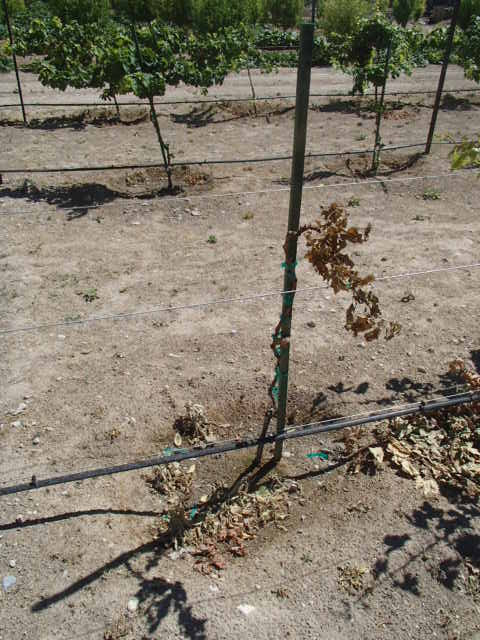Q.
I have a grape, with dark colored fruit, growing on my established trellis.
It’s already pruned. What should I do to it now?
 |
| Fantasy table grape growing in Las Vegas. |
A.
Of course your grape plant will need water and fertilizer when it starts
growing in March. I would apply the fertilizer the first week of March and
begin watering weekly during February.
 |
| As new growth appears, you should already be watering once a week and have any fertilizer applied. to help push new growth. |
Which fertilizer to use? Any fertilizer
used for fruit trees will work. It’s applied where the water is delivered to
the plant but at least 12 inches away from its trunk. I prefer using a rich
compost as a fertilizer instead, but it must be watered beyond any surface
mulch so it comes in contact with the moist soil underneath it.
 |
| Whether you apply compost or mineral fertilizers to help new grape growth push, do it just before new growth appears for best results. |
Grapes grow better in the hot desert if
there is “plant litter” (surface mulch) on top of the soil where they receive
their water. This surface mulch of 3 to 4 inches deep helps keep the soil
surrounding their roots moist and cool. Woodchips from landscape trees make an
ideal surface mulch for grapes and fruit trees because they easily rot and
decompose into the soil.
 |
| Wood, whether its from “forests” or urban forests is a valuable and rare commodity in the desert. |
Here woodchips are being dropped at the Ahern Orchard in Las Vegas to be used for soil enhancement around fruit trees and grapes.
It’s helpful to determine if your grape
should be “spur pruned” or “cane pruned”. Bunches of grapes are always produced
along last year’s growth. The difference when pruning different types of grapes
is where the fruit is produced along this new growth. Spur pruned grapes
produce their bunches at the base of last year’s growth. Cane pruned grapes
produce their bunches from buds further out from this. Buds that produce grape
bunches further out, when spur pruned short, are void of grape bunches. Pay
attention to your variety of grape and whether it prefers spur or cane pruning.
 |
| Grapes and fruit trees grow much better and with fewer problems when NOT grown in bare soil but the soil covered in woodchip mulch. |
Simplest way is to delay pruning until you
see grape bunches starting to form. I know it can be heart-wrenching, just like
thinning peach trees, but removing extra bunches will make each of the berries
in the grape clusters larger.
When it’s an unknown grape variety I’m not
sure about, I look for old grape clusters, remnants, produced last season. (I will take a few shots of this and insert later. I dont have any shots of this yet.) These
can be subtle differences and not obvious to the casual observer. Count back
the number of bumps or “buds” where these remnants were attached to older
growth. Do this in several locations and get an “average” distance from where
it grew. This tells you where you can safely prune last years growth and how
much can be removed. Doing this can insinuate if a grape should be spur pruned
or cane pruned in the future.